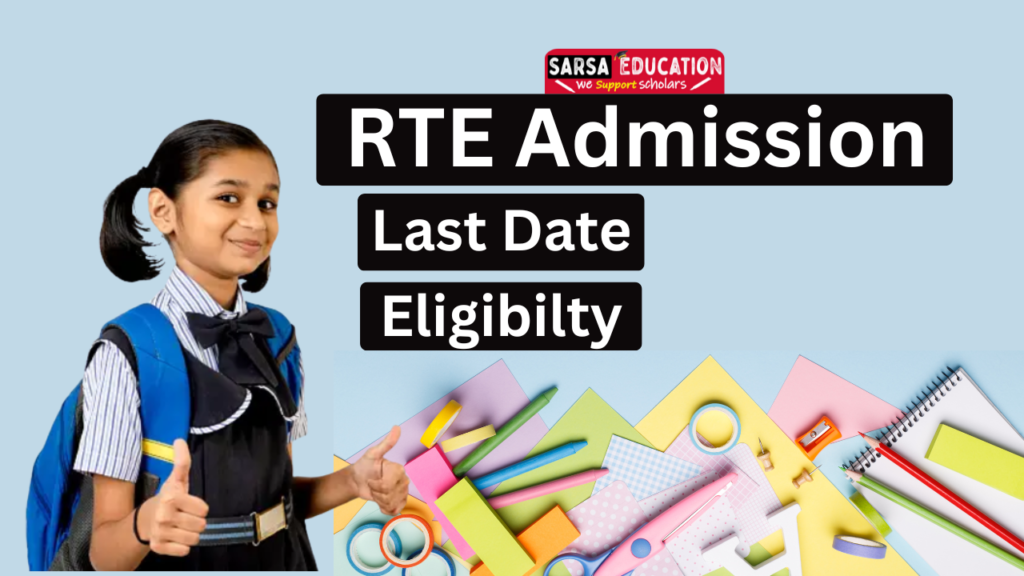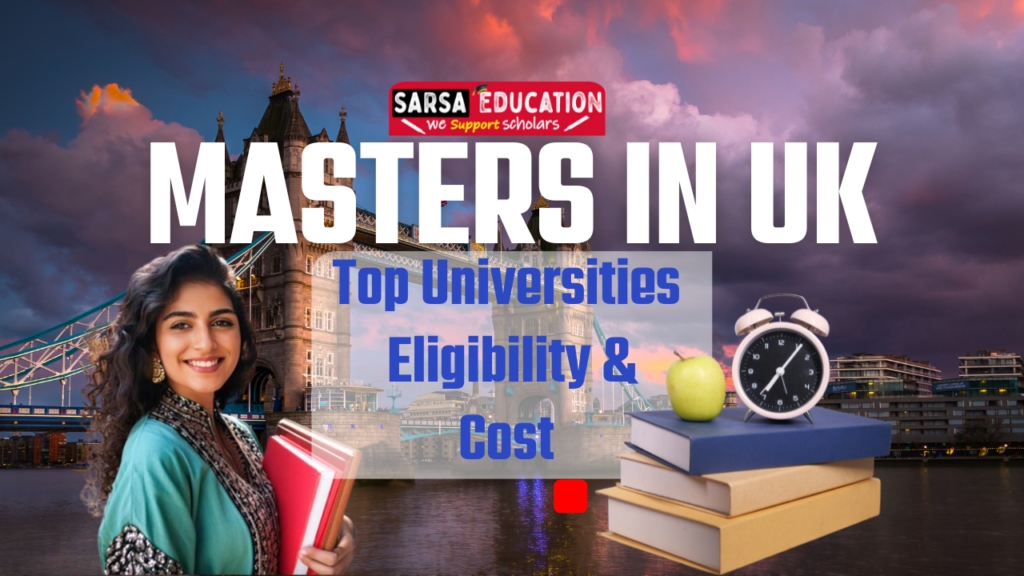Contents
Right to Education-RTE
- The Right of Children to Free and Compulsory Education Act, 2009, came into effect on April 1, 2010.
- Right to Education-RTE stands for the Right of Children to Free and Compulsory Education Act, 2009. It is an Indian law that guarantees free and compulsory education to all children between the ages of 6 and 14 years.
- It makes education a fundamental right under Article 21A of the Indian Constitution.
- The Act applies to the entire country. Earlier, it did not include Jammu & Kashmir but it has now been extended to cover it.
- In Jharkhand, it is implemented through the Jharkhand Right to Education-RTE Rules, 2011.
Important links
- Masters in UK Fully Funded
- Benefits of Online MBA
- MBBS Abroad with Scholarships
- Study in Germany for free for Indian Students
Eligibility Criteria
Right to Education-RTE
1. Age Limit
- Primary Stage: Classes 1 to 5 (Ages 6 to 10)
- Upper Primary Stage: Classes 6 to 8 (Ages 11 to 14)
2. Children Eligible for RTE Admissions
Economically Weaker Section (EWS):
Annual family income limit: Approximately ₹3.5 lakhs or less, depending on state regulations.
Disadvantaged Group (DG):
- SC, ST, OBC (as notified by the state).
- Orphans, street children, and child laborers.
- Children with disabilities.
- Children affected by HIV, children of war widows, and children of migrant workers.
3. Proof of Residence
Right to Education-RTE
- Applicants must be residents of the local area or the state in which admission is sought.
4. Types of Schools Covered
Right to Education-RTE
- All private unaided schools are required to reserve 25% of seats for children from Economically Weaker Sections (EWS) and Disadvantaged Groups (DG).
- Free education is also guaranteed in government and aided schools.
5. 25% Reservation in Private Schools
- At entry-level classes for children from EWS and DG categories.
- Collection of donations or capitation fees is strictly prohibited.
6. Admission Without Screening Tests or Capitation Fees
- Under the RTE quota, private and government schools are prohibited from conducting any admission tests or interviews for children or parents, under the Right to Education-RTE quota.
7. Bridge Courses for Out-of-School Children
- Bridge courses and special training programs are provided to out-of-school children before they are integrated into age-appropriate classes.
8. Community Awareness Programs
- Helps in reducing dropouts and ensuring regular attendance.
- RTE mandates awareness campaigns for parents and communities about children’s right to education.
Key Features
Right to Education-RTE
1. Free and Compulsory Education
- No tuition fees are charged until the completion of elementary education.
2. School Infrastructure Essentials
- One classroom per teacher.
- Separate toilets for boys and girls.
- Safe drinking water.
- Playground and library.
3. Curriculum & Learning Outcomes
- Child-friendly and activity-based curriculum is emphasized.
- Focus is on learning outcomes, not rote learning.
- Includes moral, social, and life skills education.
4. Learning Without Fear till Class 8
- Students cannot be failed or expelled up to Class 8.
- They are evaluated through the Continuous and Comprehensive Evaluation (CCE) system.
5. School Management Committees (SMCs)
- In government schools, 75% of the members are parents or guardians.
- They monitor teachers, facilities, and the use of school funds.
6. No Punishment and No Discrimination
Right to Education-RTE
- No physical or mental punishment
- Children cannot be subjected to corporal punishment (like beating, slapping, or any physical harm).
- No Discrimination
- Children must not face discrimination based on caste, religion, gender, disability, or socio-economic background.
- Ensures a safe, inclusive, and respectful learning environment for all students.
- Purpose
- Promotes child-friendly education.
- Encourages children to learn without fear.
- Helps in building confidence and equality among students.
- Schools Recognition
- The government must recognise schools under the Right to Education-RTE rules.
- Unrecognized schools cannot operate legally.
7. Child Rights and Participation
- Children’s feedback is encouraged in classroom learning and school improvement.
- RTE promotes student participation in school activities and decision-making.
Related Links
- Top Scholarships for the 12th class.
- Top Scholarships for B.Com students.
- Top Scholarships for Engineering Students.
- Top Scholarships for B.Sc students.
Benefits
Right to Education-RTE
1. Universal Education
- Ensures that every child has the opportunity to study, irrespective of caste, religion, gender, or economic status.
2. Equality in Education
- Provides children from economically weaker backgrounds access to quality private schools.
3. Financial Relief
- Parents benefit financially as tuition, uniforms, textbooks, and meals are provided free of cost.
4. Reduces Child Labour
- Encourages children from economically weaker families to pursue education rather than engage in child labor.
5. Improves Literacy Rate
- Contributes to improving literacy levels in Jharkhand and across India.
6. Inclusive Education
- Ensures inclusive education with special focus on girls, SC/ST communities, children with disabilities, and minority groups.
7. Better Quality of Schools
Right to Education-RTE
- Since schools must follow norms (toilets, classrooms, teachers), overall school quality improves.
8. Community Participation
- Through School Management Committees (SMCs), parents participate in monitoring schools, ensuring accountability.
9. Long-Term Benefits
- Education contributes to poverty reduction, enhances employment opportunities, promotes health awareness, and empowers communities.
10. Use of Technology in Education
- Helps children in better understanding and interactive learning.
- Encourages the use of digital learning tools, smart classrooms, and educational apps.

Skill-Related Benefits
Right to Education-RTE
1. Literacy and Numeracy Skills
- Children acquire literacy and numeracy skills, forming the foundation for all future learning and career opportunities.
2. Communication Skills
Right to Education-RTE
- RTE schools teach children to speak, listen, and express ideas in Hindi, English, or their mother tongue, thereby building confidence.
3. Social Skills
- Studying alongside children from diverse backgrounds helps develop teamwork, cooperation, respect, and tolerance.
4. Critical Thinking & Problem-Solving
- Children develop critical thinking and problem-solving skills through projects, activities, and continuous evaluation.
5. Life Skills
- Education under the Right to Education-RTE teaches discipline, hygiene, safety, time management, decision-making, and handling challenges.
6. Digital Skills
- Children gain basic computer knowledge, internet awareness, and digital literacy, preparing them for a technology-driven world.
7. Creativity and Innovation
- Participation in art, drama, music, and creative projects fosters imagination, originality, and innovation.
8. Leadership & Responsibility
Right to Education-RTE
- Group activities, class roles, and School Management Committees (SMCs) give children chances to lead, organize, and take responsibility.
9. Gender Sensitivity & Equality Awareness
- Boys and girls studying together under the Right to Education-RTE learn mutual respect, equal rights, and inclusiveness.
10. Employability Skills (Future-Oriented)
- With strong foundations, children are better prepared for vocational training, higher studies, and future employment, enhancing their employability
Examination
Right to Education-RTE
1. Continuous and Comprehensive Evaluation (CCE)
- Rather than relying on a single major exam, the Right to Education-RTE introduced Continuous and Comprehensive Evaluation (CCE), which focuses on continuous learning assessment.
- Students’ learning is regularly assessed throughout the year through:
- Class tests
- Projects & assignments
- Classroom activities and participation
- Oral tests
- Goal: To check overall development (knowledge + skills + behaviour).
2. No Detention Policy (Earlier Rule)
- From 2010 to 2017, no student from Classes 1 to 8 could be failed.
- Examinations were conducted, but the results were used only for progress reports, not for determining pass or fail.
3. Current Exam Routine
- As per the 2019 Right to Education-RTE Amendment:
- States can conduct exams in Class 5 and Class 8.
- If a child fails, special training and a re-examination must be provided.
- If the child still does not pass, the state may permit detention (failing).
- For Classes 1 to 4 and 6 to 7, the CCE system is still followed, with no strict pass or fail policy.
4. Frequency of Evaluation
- Formative Assessments (FA):
- Small tests, quizzes, classwork, and oral activities.
- Conducted 4 times a year (every 2–3 months).
- Summative Assessments (SA):
- Bigger tests/exams at the end of the term/semester.
- Usually conducted twice a year — Half-Yearly and Final Exams.
Summary (Routine)
Right to Education-RTE
- Classes 1 to 8: CCE with regular tests and activities.
- Exams: Small tests every 2–3 months and term exams (half yearly & annual).
- Classes 5 and 8: Formal exams (in many states) with a re-exam opportunity.
Who Can Apply
Right to Education-RTE
1. Age Criteria
- Children aged 6 to 14 years are eligible.
- This includes elementary education from Classes 1 to 8.
2. Economic & Social Criteria
- Children from low-income families are unable to afford private education.
- Children belonging to socially marginalized communities who faced discrimination or exclusion.
- Children with Special Needs (CWSN) or differently-abled children.
3. School Types
- Government Schools: Any eligible child can apply.
- Government-Aided Schools: Eligible children may apply as per state-specific norms.
- Private Schools: 25% of seats are reserved for Economically Weaker Sections (EWS) and the Disadvantaged Group (DG).
4. Other Eligible Children
Right to Education-RTE
- Out-of-School Children: Those who were never enrolled in school.
- Dropout Children: Children who dropped out earlier can re-enroll.
- Children whose families frequently move from one place to another due to work or natural disasters.
5. Admission
- Admission is allowed anytime during the academic year.
Frequently Asked Questions
Right to Education-RTE
1. What does RTE stand for?
Answer: RTE stands for the Right of Children to Free and Compulsory Education Act, 2009
2. When did RTE come into effect?
Answer: The RTE Act came into effect on 1st April 2010.
3. What is the age group covered under RTE?
Answer: The RTE Act covers children aged 6 to 14 years, corresponding to Classes 1 to 8.
4. Is education under the RTE free?
Answer: Yes, all children are entitled to free elementary education under the RTE Act.
5. Is education under RTE compulsory?
Answer: Yes, education is compulsory. Schools must admit all eligible children, and children are required to attend regularly.
6. Who is eligible to apply under RTE?
Answer: Children aged 6–14 years from Economically Weaker Sections (EWS), Scheduled Castes (SC), Scheduled Tribes (ST), Other Backwards Classes (OBC), marginalised communities, children with disabilities, dropouts, and children from migrant families are eligible to apply.
7.How many seats are reserved for Economically Weaker Sections (EWS) and Disadvantaged Groups (DG) children in private schools?
Answer: Under the RTE Act, 25% of seats in private unaided schools are reserved for children from EWS and Disadvantaged Groups (DG).
8. Who pays the fees for children admitted under this reservation?
Answer: The government reimburses the school fees for children admitted under the 25% reservation quota.
9. What is the “No Detention Policy”?
Answer: Under the No Detention Policy, students in Classes 1 to 8 cannot be failed. The focus is on continuous learning and progress.
10. Are exams conducted under RTE?
Answer:
- Students are assessed continuously through the Continuous and Comprehensive Evaluation (CCE) system, which includes class tests, projects, oral tests, and various activities.
- Formal examinations are allowed in Classes 5 and 8 (as per the 2019 amendment), along with remedial support for students who need it.
11. What is CCE?
Answer: Continuous and Comprehensive Evaluation (CCE) is an assessment system conducted throughout the year to monitor the overall development of students.
12. Can a child be admitted mid-year?
Answer: Yes, a child can be admitted at any time during the academic year.
13. Are there special provisions for children with disabilities?
Answer: Yes, inclusive education is provided for children with disabilities, including special teachers, ramps, and assistive devices.
14. What infrastructure is required under RTE?
Answer: Schools must have adequate infrastructure under RTE, including classrooms, separate toilets for boys and girls, safe drinking water, playgrounds, libraries, and a proper teacher-student ratio.
15. Are schools under RTE monitored?
Answer: Yes, schools are monitored by School Management Committees (SMCs), which oversee school performance and ensure quality education.
16. What are the benefits of RTE?
Answer: Key benefits of RTE include free education, reduced dropout rates, social inclusion, holistic development, and equality in education
17. Does RTE cover out-of-school children?
Answer: Yes, RTE gives priority admission to out-of-school and dropout children.
18. How often are assessments conducted?
Answer:
- Formative Assessments (FA): Conducted 4 times a year.
- Summative Assessments (SA): Conducted twice a year (Half-Yearly & Annual).
19. Can a child be detained under RTE?
Answer:
- Classes 1–4 and 6–7: Generally, no detention; promotion is based on CCE.
- Classes 5 and 8: Detention may be allowed by states after remedial training and re-examination, if necessary.
20. What role do parents and the community play in RTE?
Answer: Parents ensure regular attendance of children, while the community participates in school monitoring through School Management Committees (SMCs).

How to Apply
Right to Education-RTE
- Step 1: Contact Sarsa Education –email: sarsaeducation@gmail.com
- Step 2: Visit the Official RTE Website
- Step 3: Registration (Online Admission Process)
For National/International Scholarship updates kindly join our whatsApp channel
Follow the Sarsa Education channel on WhatsApp: https://whatsapp.com/channel/0029VaL9SgRAjPXJthnK9D0E
In case of any queries, please reach out to:
Email: scholarship.sarsa@gmail.com







